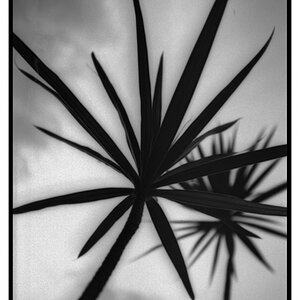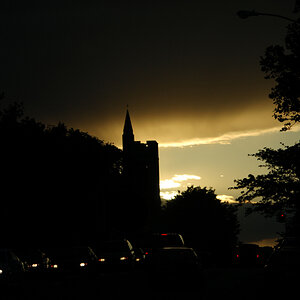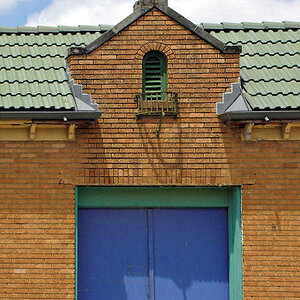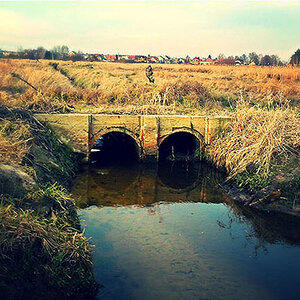Hertz van Rental
We're supposed to post photos?
Just some of my current thinking (shorn of references, quotes, big words and long-winded arguments for the sake of brevity) on one particular aspect of Photography. One or two may find it of some interest.
There are a number of questions that arise naturally from the practice of Photography when the fundamental principles guiding the whole process of Photography are forgotten – or not understood in the first place.
These fundamental principles have are nothing to do with the Technical processes or Aesthetics (though these aspects are inherent and subservient) but underpin the act of Photography itself.
What is the basis of Photography? What is it all about in the purest sense?
Photography is solely concerned with the recording and transmission of information.
Photography is a process whereby marks are made on a surface. These marks are a record of light generated/transmitted/reflected by physical phenomena. The process is carried out in a way that allows the record (the marks) to correspond almost exactly with the original, and in a form that can be apprehended to give a visual sensation analogous to that of the original.
In short, Photography gives a visual re-presentation of the original.
To put it simply: a photograph looks like that which has been photographed at the time it was photographed.
By this process information is recorded to give a direct correlation between the object and the image, and the information is available for retrieval at a later date.
The act of Photography falls naturally into two distinct parts, each an entirely separate process but both inextricably linked by the image.
There is the act of taking the picture and the act of viewing the picture.
First let us look at the act of taking.
It is important to realise that the act of taking a picture is not a random act, it is premeditated. In order to take a photograph it is necessary to have the means to do it. There is therefore the requirement to plan ahead to have the means available, and acquiring the means indicates the intention to use it.
Carrying a camera demonstrates this intention and predisposes the photographer to actively look for things to photograph. It does not, of course, follow that the photographer must use the camera, but having a camera allows it’s use and if the photographer did not intend, even at the sub-conscious level, to use it there would not be the requirement of a camera.
From this it follows that the notion of the photographer as a ‘detached observer’ is erroneous.
By carrying a camera the photographer is displaying his intent to photograph. He is, therefore, actively looking for things to photograph and so observes ‘reality’ in order to identify and isolate suitable subject matter. But by observing ‘reality’ one must of necessity interact with it.
Interaction invokes a response and inanimate subjects will respond passively, animate ones actively. The photographer for his part will respond actively and his response will include framing, focussing, selecting what to photograph and when to release the shutter. And this sequence of responses will be guided by the photographer’s Social and Cultural conditioning.
The act of taking a picture therefore becomes a pre-meditated, selective and programmed response to a situation.
It also pre-supposes a viewer.
To initiate an act of Photography is to demonstrate an expectation that the image will be viewed at some point, even if it is by no one other than the photographer and for no other reason than curiosity. This is because the photographer is aware of the end product of the process and it’s function: that is to say, the production of an object whose sole purpose is to be viewed.
If there is no intention of having the produced image viewed by someone at some point then there is no purpose in taking the picture in the first place. It becomes a redundant act.
The act of taking a picture now becomes a pre-meditated, selective and programmed response to a situation for the benefit of a viewer.
Let us now examine the second act, that of viewing an image.
‘Anything reasoned is never universal, timeless and stable. Any meaning is only provisional and relative because it is never exhaustive.’
An image has meaning to a viewer through a process of analysis, interpretation and association. And each viewer will find a different meaning, even though the differences may be very small.
It follows that the image is capable of almost infinite interpretation, if all meanings are valid and of equal value, which renders the image essentially meaningless.
Meaning must therefore be projected on to the image by the viewer. It resides solely in the viewer’s mind and not in the image.
Meaning exists outside, and independent of, the image.
The meaning ascribed by a viewer to an image will, however, be influenced by the Cultural and Sociological conditions of their Society, as well as their personal condition, at the time of viewing. That is to say, any viewer’s interpretation of an image will be rooted in their time and be of that time.
Meaning will change with time.
It follows that only a finite range of meanings will be possible at any particular time as the possible interpretations will be bounded and defined by the prevailing culture. Therefore at any given time only a finite range of interpretations are available to a viewer.
The range of possible meanings is reduced further by the content of the image. What the image is of will dictate, to a large extent, the possible meanings. One cannot ascribe meaning based on what is not present as this would make the process impossible.
Absence can have an influence, but only when what is absent is in binary opposition to something that is present. That is, when what is present only has meaning by being compared with it’s opposite. In this case what is absent has presence because it is inherent in, and implied by, it’s opposite.
Meaning can only be ascribed to what is present, not to what is not present.
As the act of taking a picture pre-supposes a viewer, so too does the act of viewing an image pre-suppose a photographer. Without a photographer there would be no image to view.
If the range of possible meanings of an image is dictated, to some extent, by it’s content and this content is decided, to some extent, by the photographer then the range of possible meanings of an image must be dictated, to some extent, by the photographer.
The process of Photography can thus be seen (in part) as a dialogue between photographer and viewer, the rules governing this dialogue being laid down by Society.
There are a number of questions that arise naturally from the practice of Photography when the fundamental principles guiding the whole process of Photography are forgotten – or not understood in the first place.
These fundamental principles have are nothing to do with the Technical processes or Aesthetics (though these aspects are inherent and subservient) but underpin the act of Photography itself.
What is the basis of Photography? What is it all about in the purest sense?
Photography is solely concerned with the recording and transmission of information.
Photography is a process whereby marks are made on a surface. These marks are a record of light generated/transmitted/reflected by physical phenomena. The process is carried out in a way that allows the record (the marks) to correspond almost exactly with the original, and in a form that can be apprehended to give a visual sensation analogous to that of the original.
In short, Photography gives a visual re-presentation of the original.
To put it simply: a photograph looks like that which has been photographed at the time it was photographed.
By this process information is recorded to give a direct correlation between the object and the image, and the information is available for retrieval at a later date.
The act of Photography falls naturally into two distinct parts, each an entirely separate process but both inextricably linked by the image.
There is the act of taking the picture and the act of viewing the picture.
First let us look at the act of taking.
It is important to realise that the act of taking a picture is not a random act, it is premeditated. In order to take a photograph it is necessary to have the means to do it. There is therefore the requirement to plan ahead to have the means available, and acquiring the means indicates the intention to use it.
Carrying a camera demonstrates this intention and predisposes the photographer to actively look for things to photograph. It does not, of course, follow that the photographer must use the camera, but having a camera allows it’s use and if the photographer did not intend, even at the sub-conscious level, to use it there would not be the requirement of a camera.
From this it follows that the notion of the photographer as a ‘detached observer’ is erroneous.
By carrying a camera the photographer is displaying his intent to photograph. He is, therefore, actively looking for things to photograph and so observes ‘reality’ in order to identify and isolate suitable subject matter. But by observing ‘reality’ one must of necessity interact with it.
Interaction invokes a response and inanimate subjects will respond passively, animate ones actively. The photographer for his part will respond actively and his response will include framing, focussing, selecting what to photograph and when to release the shutter. And this sequence of responses will be guided by the photographer’s Social and Cultural conditioning.
The act of taking a picture therefore becomes a pre-meditated, selective and programmed response to a situation.
It also pre-supposes a viewer.
To initiate an act of Photography is to demonstrate an expectation that the image will be viewed at some point, even if it is by no one other than the photographer and for no other reason than curiosity. This is because the photographer is aware of the end product of the process and it’s function: that is to say, the production of an object whose sole purpose is to be viewed.
If there is no intention of having the produced image viewed by someone at some point then there is no purpose in taking the picture in the first place. It becomes a redundant act.
The act of taking a picture now becomes a pre-meditated, selective and programmed response to a situation for the benefit of a viewer.
Let us now examine the second act, that of viewing an image.
‘Anything reasoned is never universal, timeless and stable. Any meaning is only provisional and relative because it is never exhaustive.’
An image has meaning to a viewer through a process of analysis, interpretation and association. And each viewer will find a different meaning, even though the differences may be very small.
It follows that the image is capable of almost infinite interpretation, if all meanings are valid and of equal value, which renders the image essentially meaningless.
Meaning must therefore be projected on to the image by the viewer. It resides solely in the viewer’s mind and not in the image.
Meaning exists outside, and independent of, the image.
The meaning ascribed by a viewer to an image will, however, be influenced by the Cultural and Sociological conditions of their Society, as well as their personal condition, at the time of viewing. That is to say, any viewer’s interpretation of an image will be rooted in their time and be of that time.
Meaning will change with time.
It follows that only a finite range of meanings will be possible at any particular time as the possible interpretations will be bounded and defined by the prevailing culture. Therefore at any given time only a finite range of interpretations are available to a viewer.
The range of possible meanings is reduced further by the content of the image. What the image is of will dictate, to a large extent, the possible meanings. One cannot ascribe meaning based on what is not present as this would make the process impossible.
Absence can have an influence, but only when what is absent is in binary opposition to something that is present. That is, when what is present only has meaning by being compared with it’s opposite. In this case what is absent has presence because it is inherent in, and implied by, it’s opposite.
Meaning can only be ascribed to what is present, not to what is not present.
As the act of taking a picture pre-supposes a viewer, so too does the act of viewing an image pre-suppose a photographer. Without a photographer there would be no image to view.
If the range of possible meanings of an image is dictated, to some extent, by it’s content and this content is decided, to some extent, by the photographer then the range of possible meanings of an image must be dictated, to some extent, by the photographer.
The process of Photography can thus be seen (in part) as a dialogue between photographer and viewer, the rules governing this dialogue being laid down by Society.






![[No title]](/data/xfmg/thumbnail/35/35868-15d995e4052bf05e2038e8b2a545a08f.jpg?1619737195)







